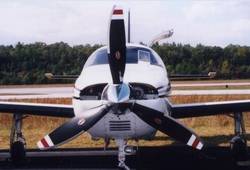|
|
Intersting artical. I know at least 3 folks that have changed form there old simitar to this new one and found better climb and some say 15/20 kts more cruise on the Lancair IV. How do you MT 4 blade guys feel about this in comparison? JIM Hergert
Tue, Dec 10 2002
Hartzell Reveals Aerodynamic Technology
Hartzell Propeller has announced the introduction of advanced new propeller design capabilities. Incorporation of the new technology that the company says will allow Hartzell aerodynamicists the ability to more readily maximize various elements of propeller performance in specific applications.

New propeller designs based on this philosophy are already being made available on many popular general aviation aircraft. Examples include original equipment propellers for the Cirrus SR20 and SR22, the Lancair Legacy and the SOCATA TB20 and TB21. Recent STC'd installations include the Beechcraft Bonanza, Cessna 340 and 414, Piper Dakota and many others. Application of this technology is continuing on new applications, where appropriate.
A little this, a little that = performance The "blended" propeller designs allow for the incorporation of different airfoils along progressive sections of a blade. Thus, the design of the blade mid?section may be maximized for developing low-speed thrust while the tip sections may be optimized to reduce noise levels. In the past, most propeller designs for aircraft equipped with piston engines made use of one basic airfoil series across the entire length of the blade (which can compromise aircraft performance or produce high noise levels). The "blended" propeller designs allow for the incorporation of different airfoils along progressive sections of a blade. Thus, the design of the blade mid?section may be maximized for developing low-speed thrust while the tip sections may be optimized to reduce noise levels. In the past, most propeller designs for aircraft equipped with piston engines made use of one basic airfoil series across the entire length of the blade (which can compromise aircraft performance or produce high noise levels).
The evidence is in the record books: In addition, the blended airfoil design process was implemented in conjunction with new propeller planform designs, such as Hartzell's 'swept-tip scimitar' props. When properly engineered, the use of tip sweep minimizes the strength of the sonic shock wave at the propeller blade tips and in combination with the blended airfoil designs can provide significant reductions in noise and increased performance. In addition, the blended airfoil design process was implemented in conjunction with new propeller planform designs, such as Hartzell's 'swept-tip scimitar' props. When properly engineered, the use of tip sweep minimizes the strength of the sonic shock wave at the propeller blade tips and in combination with the blended airfoil designs can provide significant reductions in noise and increased performance.
The new technology was developed by Hartzell through its involvement in various specialized applications for NASA, as well as for record breaking propellers designed for Bruce Bohannon's Exxon Flyin' Tiger and for record setting Lancairs racing at Reno. At the same time Hartzell has recently developed advanced next generation manufacturing capabilities for propeller blades. The goals of all these efforts are to produce mission optimized propellers able to incorporate absolute maximum flight performance, reduced noise profiles and greater blade-to-blade accuracy.
FMI: www.hartzellprop.com
|
|